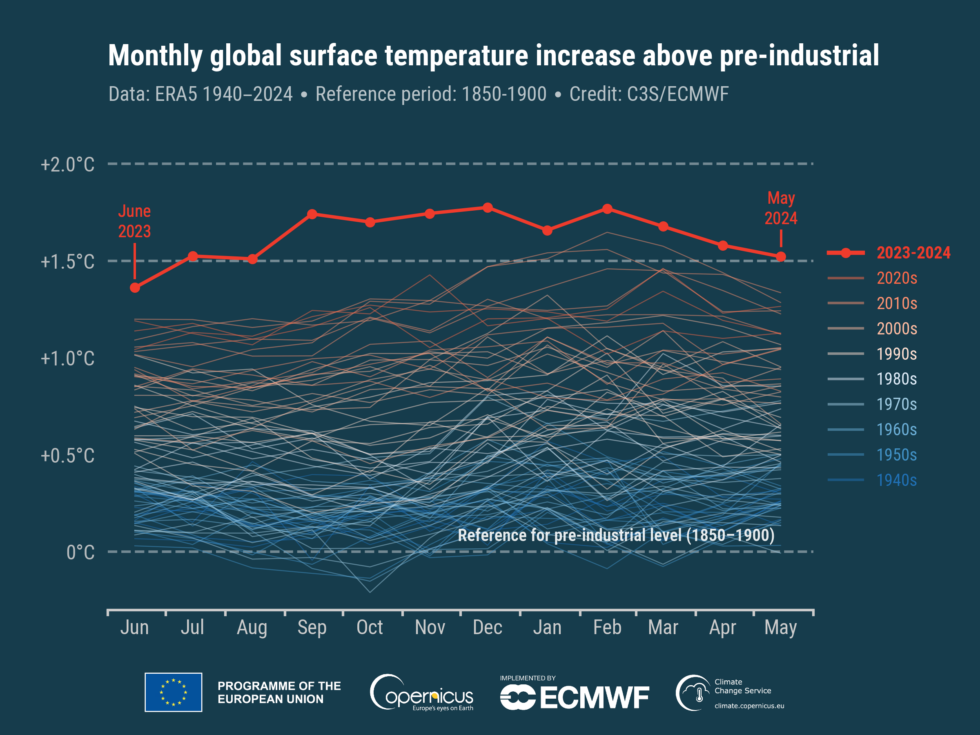Every month is above average —
Last June was the warmest June on record. Every month since has been similar.

June 2023 did not seem like an exceptional month at the time. It was the warmest June in the instrumental temperature record, but monthly records haven’t exactly been unusual in a period where the top 10 warmest years on record have all occurred within the last 15 years. And monthly records have often occurred in years that are otherwise unexceptional; at the time, the warmest July on record had occurred in 2019, a year that doesn’t stand out much from the rest of the past decade.
But July 2023 set another monthly record, easily eclipsing 2019’s high temperatures. Then August set yet another monthly record. And so has every single month since, a string of records that propelled 2023 to the warmest year since we started keeping track.
Yesterday, the European Union’s Copernicus Earth-monitoring service announced that we’ve now gone a full year where every single month has been the warmest version of that month since we’ve had enough instruments in place to track global temperatures.

Enlarge / History monthly temperatures show just how extreme the temperatures have been over the last year.
As you can see from this graph, most years feature a mix of temperatures, some higher than average, some lower. Exceptionally high months tend to cluster, but those clusters also tend to be shorter than a full year.
In the Copernicus data, a similar year-long streak of records happened once before (recently, in 2015/2016). NASA, which uses slightly different data and methods, doesn’t show a similar streak in that earlier period. NASA hasn’t released its results for May’s temperatures yet—they’re expected in the next few days. But it’s very likely that NASA will also show a year-long streak of records.
Beyond records, the EU is highlighting the fact that the one-year period ending in May was 1.63° C above the average temperatures of the 1850–1900 period, which are used as a baseline for preindustrial temperatures. That’s notable because many countries have ostensibly pledged to try to keep temperatures from exceeding 1.5° above preindustrial conditions by the end of the century. While it’s likely that temperatures will drop below the target again at some point within the next few years, the new records suggest that we have a very limited amount of time before temperatures persistently exceed it.

Enlarge / For the first time on record, temperatures have held steadily in excess of 1.5º above the preindustrial average.
Realistically, those plans involve overshooting the 1.5° C target by midcentury but using carbon capture technology to draw down greenhouse gas levels. Exceeding that target earlier will mean that we have more carbon dioxide to pull out of the atmosphere, using technology that hasn’t been demonstrated anywhere close to the scale that we’ll need. Plus, it’s unclear who will pay for the carbon removal.
The extremity of some of the monthly records—some months have come in a half-degree C above any earlier month—are also causing scientists to look for reasons. But so far, the field hasn’t come to a consensus regarding the sudden surge in temperature extremes.
Because it has been accompanied by significant warming of ocean temperatures, a lot of attention has focused on changes to pollution rules for international shipping, which are meant to reduce sulfur emissions. These went into effect recently and have cut down on the emission of aerosols by cargo vessels, reducing the amount of sunlight that’s reflected back to space.
That’s considered likely to be a partial contributor. A slight contribution may have also come from the Hunga Tonga eruption, which blasted significant amounts of water vapor into the upper atmosphere, though nowhere near enough to explain this warming. Beyond that, there are no obvious explanations for the recent warmth.